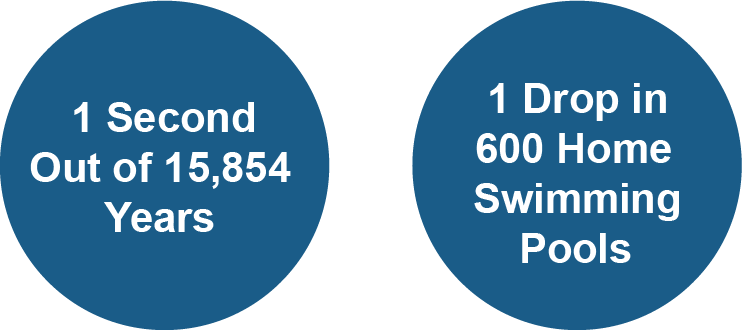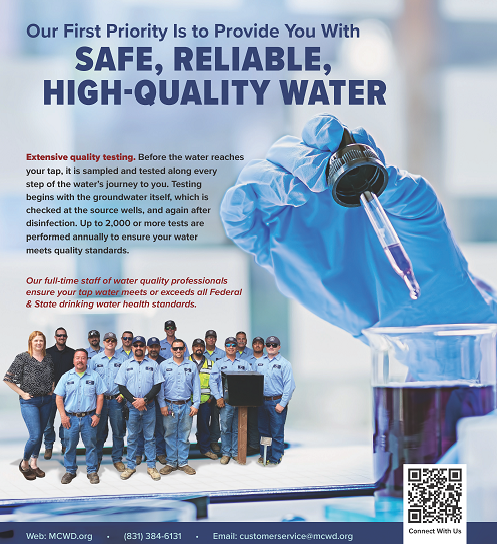Our First Priority Is to Provide Customers With High Quality Water
Your tap water meets or exceeds all Federal and State drinking water health standards thanks to our full-time staff of water quality professionals who diligently monitor and safeguard your water supplies 24/7.

State Certified Operators. MCWD's Operations and Maintenance team is composed of highly certified drinking water professionals who are on the job every day to ensure that your water continually meets quality standards.
Extensive Quality Testing. Before the water reaches your tap, it is sampled and tested along every step of the water's journey to you. Testing begins with the groundwater itself, which is checked at the source wells, and again after disinfection. In total, up to 2,000 or more tests are performed per year to ensure all water is meeting water quality standards.
Independent, State-Certified Laboratories conduct all the District's testing. These test results are automatically reported to the State, where they are confirmed and tracked.
Disinfection for Quality. Small amounts of chlorine provide protection against potential disease-causing organisms.
Automated Monitoring and Backup Systems for Reliability. Additional testing, backup power, and automated monitoring systems ensure that the entire water system is working properly, so you always receive quality water.
We test for over 200 substances and can detect as little as 1 drop of a substance in 500 billion drops of water.
Approximate Equivalence:

Consumer Confidence Report (CCR)
The Marina Coast Water District is committed to supplying water that meets or surpasses all State and Federal drinking water standards. We are proud to present annual summaries of our most recent water quality testing results, including details about where your water comes from, what it contains, and how it compares to drinking water standards. We encourage you to read the reports and to save them for future reference.
2024 Consumer Confidence Report (PDFs): English, Korean, Spanish, Tagalog, or Vietnamese.
Previous Years
2023: English, Korean, Spanish, Tagalog, or Vietnamese
2022: English, Korean, Spanish, Tagalog, or Vietnamese
2021: English, Korean, Spanish, Tagalog, or Vietnamese
2020: English, Korean, Spanish, Tagalog, or Vietnamese
2019: English, Korean, Spanish, Tagalog, or Vietnamese
If you have questions about water quality: please contact our Customer Service Department at (831) 384-6131 or (831) 883-5900.
Public Health Goal Report
Public Health Goals (PHGs) Report for drinking water are set by the Office of Environmental Health Hazard Assessment (OEHHA). California Health and Safety Code 116470 requires public water systems with more than 10,000 service connections to prepare a report if water quality measurements exceed Public Health Goals (PHGs) or Maximum Contaminant Level Goals (MCLGs). PHGs and MCLGs differ from Maximum Contaminant Levels (MCLs), as the latter are enforceable limits set by the EPA and the State Water Resources Control Board (State Board). The PHG report(s) below will list all the contaminants that were detected within the District's water sources as well as the Best Available Treatment Technology and Cost Estimates that would be required to remove the contaminants.
2025 Public Health Goal Report (PDFs): English, Korean, Spanish, Tagalog, Vietnamese.
Intensive Sampling of All Drinking Water Quality Standards
The District collects and analyzes regulatory water samples, which monitor compliance for over 200 constituents in the drinking water. Many of these constituents are naturally occurring substances. The water supply samples are tested for general minerals such as calcium, magnesium, and hardness; inorganic chemicals such as arsenic, chromium, and other metals; organic chemicals such as solvents, pesticides, and herbicides; radioactivity, including radon. The distribution system is also tested for disinfection by-products by testing for total trihalomethanes (TTHMs) and haloacetic acids (HAA5's).
Our regularly scheduled water sampling program and prudent operations and maintenance team ensure that your water meets all State and Federal drinking water standards.
More Information About Water Quality
The United States has some of the safest public water supplies in the world. Our drinking water is treated and monitored to ensure that the water being delivered is safe for consumption. While our water is safe, drinking water quality and management are understandably complicated. Slight traces of naturally occurring or man-made substances can sometimes find their way into tap water, as summarized below.
Ten Bacteria Tests Each Week. The District samples for coliform bacteria (Total and E.coli) in the distribution system every week as a part of our routine sampling program. Samples are collected from state-approved distribution system locations, consisting of ten routine samples per week; a different set of ten is analyzed each week.
Hardness. Due to the mineral content that is naturally present in the groundwater, there is increased water hardness. While there is no drinking water standard for hardness, the District continues to monitor the hardness scale of samples collected throughout the year.
Whether you have a tankless or tank water heater, the District recommends flushing your water heater regularly as per the manufacturer's recommendation to help avoid mineral deposits which can build up over time and significantly reduce the life of your water heater as well as cause some water quality issues.
Lead and Copper. The District samples for Lead and Copper on a triennial basis, as required by the State Water Resources Control Board, Division of Drinking Water. Compliance with the lead and copper action levels is based on the 90th percentile lead and copper levels. This means that the concentration of lead and copper must be less than or equal to the action level in at least 90% of the samples collected. The District collects a minimum of 30 samples from customers' sinks every three years and analyzes them for lead and copper. While the District cannot control the lead and copper levels once the water leaves the service main, the District does work with homeowners and property managers to create a "find-and-fix" approach to reducing the levels of lead and copper. The District was below the action level at the 90th percentile for both copper and lead in its latest sampling event in 2022.
The District performed its initial lead inventory and submitted it to the State Water Resource Control Board, Division of Drinking Water, on October 8, 2024. All service lines were verified as non-lead within the Marina Coast Water District's service area. Please see the attached letter for more information regarding the initial lead inventory:
To learn more about the Lead and Copper Rule (LCR), please visit: https://www.waterboards.ca.gov/drinking_water/certlic/drinkingwater/leadandcopperrule.html
Trichloroethylene (TCE). TCE was a common solvent used by the U.S. Army on the former Fort Ord. TCE has been detected in wells 29 and 31 at low levels, with the average level from the source wells at 0.4 parts per billion (ppb). This is far below the Public Health Goal (PHG), which is determined by a level that would not cause significant adverse health effects in people who drink the same water every day for 70 years, is 1.7 ppb for TCE. The Maximum Contaminant Level (MCL), which is the maximum level of a contaminant that can be within the drinking water, is 5 ppb for TCE. The District continues to monitor for TCE in its water supply regularly.
Per-and-Poly-Fluoroalkyl Substances (PFAS). When the former Fort Ord was in service, the U.S. Army used foaming agents with PFAS to put out fuel fires. Thousands of chemicals fall under the PFAS umbrella. As of April 10, 2024, the EPA established legally enforceable levels, MCLs, for six PFAS in drinking water. The EPA also finalized health-based, non-enforceable Maximum Contaminant Level Goals (MCLGs) for these PFAS. The District collected PFAS sampling in all wells and samples were analyzed by independent and State-Certified laboratories; all samples were non-detect for PFAS chemicals.
Thinking About PFAS In Drinking Water from the Water Research Foundation
More information about PFAS from the State Water Board
More information about PFAS from the US Environmental Protection Agency
Monitoring Data for Constituents Without Standards. The District also samples for a series of unregulated contaminants, which are those that do not yet have drinking water standards set by the EPA. The purpose of monitoring unregulated contaminants is to help the EPA decide whether the contaminants should have a standard for monitoring. Every five years, the EPA issues a new list of unregulated contaminants that need to be monitored by public water systems; these lists are denoted by UCMR, or Unregulated Contaminant Monitoring Rule, and the version that is currently being used. The District conducted sampling for the UCMR5 reporting, which requires monitoring between 2023-2025. To view the results from the UCMR5 study, please click here. To view the results from the UCMR4 study (monitoring between 2018 - 2020), please click here. To view the results from the UCMR3 study (monitoring between 2013-2015), please click here.
The U.S. Army is Cleaning Up Shallow Groundwater Plumes of TCE Within the Former Fort Ord Lands
The Army operates a network of shallow groundwater monitoring wells to track the progress of the TCE cleanup efforts. The U.S. Army groundwater monitoring wells do not supply drinking water to District customers..
More information on the Army's ongoing cleanup
More About about MCL's and PHG's
2025 Monthly Water Quality Reports – Bacteria & Chlorine Residuals (PDFs)
Previous Years Quality Reports – Bacteria & Chlorine Residuals (PDFs)
Previous Years Quality Reports – List of Non-Detects (PDFs)
| 2021 2022 2023 2024 |
This notice is being sent to you by Marina Coast Water District. California State Water System ID#: CA2710017

